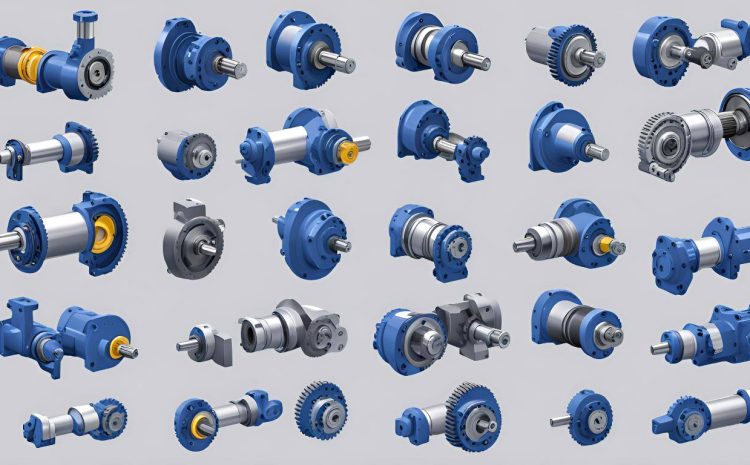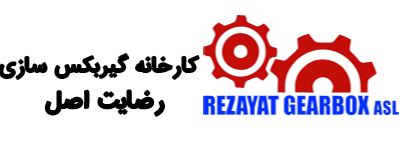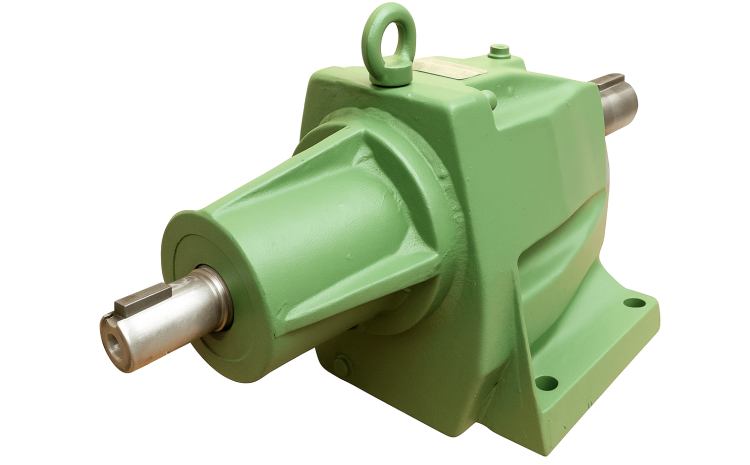
A Complete Guide to Different Types of Industrial Gearboxes
Industrial gearboxes play a critical role in ensuring that heavy machinery operates smoothly, efficiently, and reliably. Used in everything from manufacturing equipment to renewable energy systems, these devices help transmit power and modify torque to meet the specific needs of various applications. Understanding the different types of industrial gearboxes is essential for selecting the right equipment and maintaining operational efficiency. This guide explores various gearbox types, their uses, and how to maintain them for optimal performance.
Introduction to Industrial Gearboxes
What is a Gearbox?
A gearbox is a mechanical device used to increase or decrease speed, torque, and rotational power between an engine and the machinery it drives. It typically consists of a series of gears of varying sizes and configurations, all enclosed in a housing. Gearboxes are essential for machinery that requires the controlled transmission of power to function correctly.
In industrial applications, gearboxes act as intermediaries between a power source (such as an engine or electric motor) and the equipment that uses this power to perform tasks like cutting, grinding, or transporting materials. By adjusting the speed or torque of the input power, gearboxes help machinery operate more efficiently and withstand heavy loads. For instance, a planetary gearbox can reduce speed while increasing torque, making it suitable for tasks requiring precision and strength.
Importance of Gearboxes in Industrial Applications
Types of industrial gearboxes are crucial in numerous industries, such as construction, automotive, mining, and energy, among others. Without gearboxes, machinery would either work inefficiently or, in some cases, be entirely inoperable. Gearboxes ensure that equipment can handle the demands placed upon it, such as lifting heavy objects or processing materials at high speeds.
The importance of gearboxes lies not only in their ability to modify speed and torque but also in their role in improving overall machine performance. For example, a worm gearbox can deliver a self-locking function, preventing back-driving, which is essential in safety-critical applications like elevators. Similarly, gearboxes designed for heavy-duty use, such as double reduction gearboxes, provide the extra power and durability needed for high-load machinery like mining equipment.
Common Types of Industrial Gearboxes
There are various types of industrial gearboxes, each designed for specific applications. Some gearboxes are optimized for high-speed operation, while others are engineered for maximum torque. Below are the most common types and their primary uses.
Helical Gearboxes
Helical gearboxes are widely used due to their efficiency and versatility. These gearboxes feature gears that are angled, or “helical,” allowing for smoother and quieter operation compared to other gear types. The helical design ensures that the gear teeth engage gradually, which reduces noise and wear.
Helical gearboxes are commonly found in high-speed applications such as conveyors, extruders, and cooling towers. Their design also allows them to handle more significant loads and operate at higher speeds, making them ideal for industries where performance and durability are crucial. Additionally, the helical gearbox’s efficiency means that less energy is lost during transmission, which can result in cost savings over time.
Expanded Example of Helical Gearbox Applications:
In industries where precision and low noise are crucial, such as in food and beverage manufacturing, helical gearboxes ensure smooth operation while maintaining high levels of hygiene. Helical gearboxes also provide better load distribution compared to spur gearboxes, making them more efficient in transferring power over extended periods.
Worm Gearboxes
Worm gearboxes feature a worm (a screw-like gear) that engages with a worm wheel to transmit power at a right angle. These gearboxes are particularly useful for applications that require a self-locking mechanism, as the worm gear can prevent the system from moving in reverse. This is especially important in industries that rely on lifting mechanisms, such as elevators, cranes, and hoists.
One of the trade-offs of using worm gearboxes is their relatively low efficiency, which is a result of the friction between the worm and the worm wheel. However, their ability to deliver high torque at low speeds makes them valuable in machinery that operates under heavy loads.
Expanded Example of Worm Gearbox Applications:
Worm gearboxes are often used in applications that require precise motion control, such as conveyor belts or material handling systems in packaging plants. Their self-locking capabilities are also beneficial in safety-critical systems, where reverse motion could lead to accidents.
Bevel Gearboxes
Bevel gearboxes are designed to change the direction of power transmission. These gearboxes feature conical gears that mesh at right angles, making them ideal for applications where power needs to be transmitted at a 90-degree angle. Bevel gearboxes can handle a range of speeds and torques, making them versatile for many industrial applications.
These gearboxes are commonly used in applications such as power plants, automotive systems, and even aerospace machinery. Bevel gearboxes come in different varieties, including spiral bevel and straight bevel, each suited for specific tasks. Spiral bevel gears, for instance, offer more efficient power transmission and quieter operation compared to straight bevel gears.
Expanded Example of Bevel Gearbox Applications:
In automotive differentials, bevel gearboxes allow the wheels to rotate at different speeds, which is essential for safe and efficient vehicle operation, particularly when turning corners. In wind energy turbines, bevel gearboxes help change the direction of power transmission to optimize energy capture from the wind.
Planetary Gearboxes
Planetary gearboxes are compact yet powerful. They consist of a central sun gear, planet gears that orbit the sun gear, and an outer ring gear. This configuration allows for multiple points of contact, distributing the load more evenly and increasing the torque capacity of the gearbox.
Planetary gearboxes are widely used in applications where high torque and compact size are necessary, such as in automation, robotics, and mobile equipment. Their durability and efficiency make them suitable for industries like aerospace, automotive, and heavy machinery.
Expanded Example of Planetary Gearbox Applications:
In the aerospace industry, planetary gearboxes are critical in jet engines, where their ability to withstand extreme temperatures and provide high torque in a compact design is essential for optimal engine performance. Similarly, in robotics, planetary gearboxes allow for precise control and movement in a limited amount of space, which is vital in surgical robots or automated assembly lines.
Specialized Gearboxes for Unique Applications
While the common types of industrial gearboxes are suitable for a broad range of uses, some specialized gearboxes are designed to meet specific requirements. Below are a few examples of gearboxes created for unique industrial applications.
Shaft Mounted Gearboxes
Shaft-mounted gearboxes are designed to be mounted directly onto the shaft of the driven machine, eliminating the need for a coupling. This type of gearbox is commonly used in applications where space is limited or where alignment issues may be a concern.
One of the main advantages of shaft-mounted gearboxes is their ease of installation and removal. This makes them ideal for use in industries such as mining, quarrying, and material handling, where downtime must be minimized.
Expanded Example of Shaft Mounted Gearbox Applications:
In the cement industry, shaft-mounted gearboxes are commonly used in conveyor systems to move materials through the production process. Their ease of installation and robust design ensures that they can withstand the heavy loads and abrasive materials typically found in cement plants.
Rack and Pinion Gearboxes
Rack and pinion gearboxes are used to convert rotational motion into linear motion. These gearboxes consist of a round gear (the pinion) that engages with a straight gear (the rack). This setup allows for precise control of linear movement, making rack and pinion gearboxes ideal for applications like industrial gates, machine tools, and robotic systems.
Rack and pinion gearboxes are often found in industries that require accurate and reliable movement, such as automotive manufacturing and material handling. Their ability to handle heavy loads and provide consistent motion makes them invaluable in these applications.
Expanded Example of Rack and Pinion Gearbox Applications:
In the automotive industry, rack and pinion gearboxes are used in steering systems to translate the driver’s rotational input into the linear motion needed to turn the wheels. Similarly, in industrial automation, rack and pinion systems provide precise positioning for robotic arms used in assembly lines or material handling equipment.
Double Reduction Gearboxes
Double reduction gearboxes are designed to provide a significant reduction in speed while increasing torque. These gearboxes feature two stages of gear reduction, making them ideal for heavy-duty applications that require high torque at low speeds.
Double reduction gearboxes are commonly used in industries such as mining, construction, and transportation, where machinery must operate under heavy loads for extended periods. Their robust design ensures that they can withstand the harsh conditions often found in these environments.
Expanded Example of Double Reduction Gearbox Applications:
In the mining industry, double reduction gearboxes are used in equipment like crushers and conveyors, where high torque is needed to move large amounts of material. Their ability to reduce speed while increasing torque makes them essential for the efficient operation of these machines.
Custom Gearboxes
In some cases, standard gearboxes may not meet the specific requirements of an application. In these instances, custom gearboxes can be designed to provide the exact specifications needed for the job. Custom gearboxes are typically engineered to offer specific gear ratios, torque capacities, or mounting configurations that are not available in off-the-shelf gearboxes.
Custom gearboxes are often used in industries that require unique solutions, such as oil and gas, renewable energy, and aerospace. These gearboxes are designed with precision and are subjected to rigorous testing to ensure they meet the required performance standards.
Expanded Example of Custom Gearbox Applications:
In industries such as oil and gas, custom gearboxes may be required to handle extreme pressures and temperatures while ensuring precision and durability. For example, in offshore drilling rigs, gearboxes are often custom-designed to meet the specific torque and speed requirements needed to extract oil from deep beneath the ocean floor. These custom gearboxes must be incredibly durable, reliable, and able to withstand the harsh conditions of marine environments.
In renewable energy, custom gearboxes play a critical role in wind turbines, where they help optimize the rotational speed of the turbine blades to maximize energy production. These gearboxes must be designed to handle varying wind speeds and conditions while maintaining efficiency and durability over time.
Choosing the Right Gearbox for Your Needs
Selecting the right gearbox for your specific application requires careful consideration of several factors. The types of industrial gearboxes available can vary widely in terms of size, torque capacity, speed range, and durability. Below are some key factors to consider when choosing the right gearbox for your needs.
Factors to Consider When Selecting a Gearbox
- Load Requirements: The first factor to consider is the load that the gearbox will need to handle. Different applications require different levels of torque and speed, so it’s essential to select a gearbox that can meet these demands. For example, heavy machinery in industries like mining and construction may require a gearbox with a high torque capacity, such as a double reduction gearbox, while smaller applications may only need a standard helical gearbox.
- Space Constraints: The size of the gearbox is also an important consideration. Some applications may have limited space available for installation, in which case a compact planetary gearbox might be the best option. On the other hand, larger machinery with ample space can accommodate more robust gearboxes, such as bevel gearboxes or worm gearboxes.
- Speed and Efficiency: The required speed and efficiency of the gearbox should also be taken into account. For high-speed applications, such as conveyors or turbines, a helical gearbox is often the best choice due to its efficiency and ability to handle high speeds. In contrast, applications that require high torque at low speeds may benefit from a worm gearbox or double reduction gearbox.
- Operating Environment: The operating environment can have a significant impact on the type of gearbox needed. For example, gearboxes used in harsh environments, such as those in mining or marine applications, must be designed to withstand extreme temperatures, moisture, and corrosive conditions. In these cases, gearboxes made from durable materials, such as stainless steel or coated metals, are essential for long-term reliability.
- Maintenance Requirements: It’s also important to consider the maintenance requirements of the gearbox. Some gearboxes, such as worm gearboxes, require more frequent lubrication and maintenance due to the friction between the gears. Others, like planetary gearboxes, are designed for minimal maintenance, making them ideal for applications where downtime is costly.
Maintenance Tips for Industrial Gearboxes
Proper maintenance is essential for ensuring the longevity and performance of any industrial gearbox. Regular maintenance not only helps prevent costly breakdowns but also ensures that the gearbox continues to operate at peak efficiency. Below are some maintenance tips to keep in mind for your industrial gearboxes:
- Regular Inspections: Regularly inspect the gearbox for signs of wear, damage, or misalignment. Early detection of issues can help prevent more severe problems down the line.
- Lubrication: Ensure that the gearbox is properly lubricated according to the manufacturer’s recommendations. Using the correct type of lubricant is essential for reducing friction and preventing gear wear.
- Temperature Monitoring: Monitor the operating temperature of the gearbox. Excessive heat can indicate that the gearbox is under strain or that there is insufficient lubrication.
- Noise Monitoring: Listen for unusual noises, such as grinding or whining, which may indicate that the gears are misaligned or worn.
- Cleaning: Keep the gearbox clean and free from debris, which can cause overheating or damage to the gears.
- Professional Servicing: For more complex maintenance tasks, consider hiring a professional technician to service the gearbox. This can help ensure that any issues are addressed correctly and that the gearbox continues to operate efficiently.
Conclusion: The Future of Gearbox Technology
As industries continue to evolve, so too will the types of industrial gearboxes used in various applications. Advances in materials science, manufacturing techniques, and automation are driving the development of more efficient, durable, and specialized gearboxes. For example, the use of lightweight, high-strength materials, such as composites and advanced alloys, is allowing manufacturers to create gearboxes that are both more robust and more efficient.
Additionally, the rise of smart manufacturing and Industry 4.0 is leading to the development of gearboxes with integrated sensors and monitoring systems. These “smart gearboxes” can provide real-time data on performance, wear, and maintenance needs, allowing operators to make more informed decisions and prevent costly downtime.
In the renewable energy sector, gearboxes are being designed to handle the unique challenges posed by wind and solar power systems. These gearboxes must be highly efficient, durable, and capable of operating in extreme conditions. As the demand for clean energy grows, so too will the need for specialized gearboxes that can help optimize the performance of renewable energy systems.
In conclusion, understanding the different types of industrial gearboxes is essential for selecting the right equipment for your specific application. Whether you’re working in manufacturing, mining, energy, or any other industry, choosing the right gearbox can help ensure the efficiency, reliability, and longevity of your machinery.
Resources:
- Gearbox Types and Their Applications
- Helical Gearbox Benefits
- Planetary Gearbox Uses
- Worm Gearbox Efficiency
- Bevel Gearbox Technology






